When Holiday Cheer Meets a Horned Scare
As the holiday season wraps the world in a blanket of twinkling lights and merry jingles, there's one tradition that boldly strays from the usual yuletide cheer. Picture this: as the rest of the world is serenaded by carols and entranced by the dance of the sugar-plum fairy, a peculiar and thrilling deviation takes place. Welcome to Krampusnacht, a night where folklore stirs from the depths of ancient traditions, and a decidedly more, shall we say, "horned" figure takes center stage.
In stark contrast to the warm and fuzzy feelings typically associated with the holidays, Krampusnacht introduces a splash of the macabre into the festivities. It's a night that reminds us that, amidst the tinsel and the gingerbread houses, there lingers a shadowy, more mischievous side to the holiday lore. Here, instead of Santa Claus making his jolly rounds, we find Krampus, a creature of legend, who is anything but jolly.
Krampusnac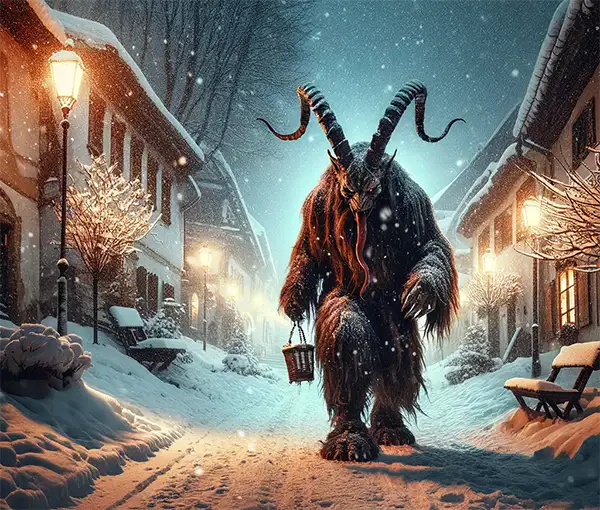 ht emerges as a daring, almost rebellious celebration, where gleeful fright and playful scares replace the usual holiday norms. This evening is an ode to the thrill-seekers and the folklore enthusiasts, a tribute to an age-old tradition that refuses to be tamed by modern holiday commercialism. It's a time when the crackling fireplaces and cozy sweaters meet the eerie echoes of a different kind of story - one that harks back to a time when myths walked the earth and legends were as real as the winter's chill.
ht emerges as a daring, almost rebellious celebration, where gleeful fright and playful scares replace the usual holiday norms. This evening is an ode to the thrill-seekers and the folklore enthusiasts, a tribute to an age-old tradition that refuses to be tamed by modern holiday commercialism. It's a time when the crackling fireplaces and cozy sweaters meet the eerie echoes of a different kind of story - one that harks back to a time when myths walked the earth and legends were as real as the winter's chill.
So, gather around, but not too close, as we delve into the enigmatic world of Krampusnacht, where the holiday spirit embraces its wild, untamed roots, offering a fascinating glimpse into a celebration that is equal parts historical, mystical, and, undeniably, a little bit spine-tingling.
A Goat-Like Blast from the Past
Krampusnacht's roots are deeply entwined in the enigmatic folds of history, much like a good holiday horror story that's been passed down through generations. Anthropologists and historians have long been intrigued by this tradition, which is believed to predate Christianity, reaching back into the dim corridors of pagan mythology. This connection to ancient beliefs and practices adds a layer of mystique and profundity to Krampusnacht, setting it apart from more modern holiday customs.
Envision a world long before the advent of the modern holiday season as we know it. While our ancestors were mastering the art of agriculture and forming the earliest communities, the legend of Krampus was already taking shape. This suggests that the fear of Krampus was used as a method of social control or as a way to explain the unexplainable in a world where superstition reigned supreme.
Delving deeper, some scholars even trace Krampus's lineage to the Wiccan deity known as the Horned God of the Witches. This deity, often depicted with the features of a goat and the embodiment of masculine energy, fertility, and the wilderness, resonates with the image of Krampus. The Horned God was revered in pagan traditions for his deep connection to nature and the cycle of life, death, and rebirth. This connection underlines the concept that Krampus is not just a seasonal scare tactic but a potent symbol of the darker, wilder forces of nature and spirituality.
In this context, Krampusnacht can be seen not just as a whimsical holiday event, but as a lingering echo of ancient rites and rituals. It's a night that reconnects us with a time when the boundaries between the human world and the realm of gods, demons, and spirits were blurred. The fact that this tradition has survived and evolved over centuries, adapting to the changing times while retaining its core essence, is a testament to its deep-seated significance in the cultural psyche.
So, when you think of Krampusnacht, remember that you're not just dealing with a modern-day boogeyman. Instead, you're encountering a character with a lineage that stretches back through the mists of time, a creature born from our ancestors' attempts to understand and personify the forces of nature and the unknown. Talk about an old family tree, indeed!
The Dark Counterpart to Jolly St. Nick
While the world is busy decking the halls with boughs of holly and singing carols of good cheer, Krampusnacht presents a striking contrast as the darker, more mischievous sibling to the feast of St. Nicholas. In this fascinating interplay of light and shadow, Krampus emerges as the antithesis to the benevolent and jolly Santa Claus. Think of Krampus as Santa's shadow, a figure lurking in the background, not with gifts and merriment, but with a naughty list that's not only twice as long but also infinitely more menacing.
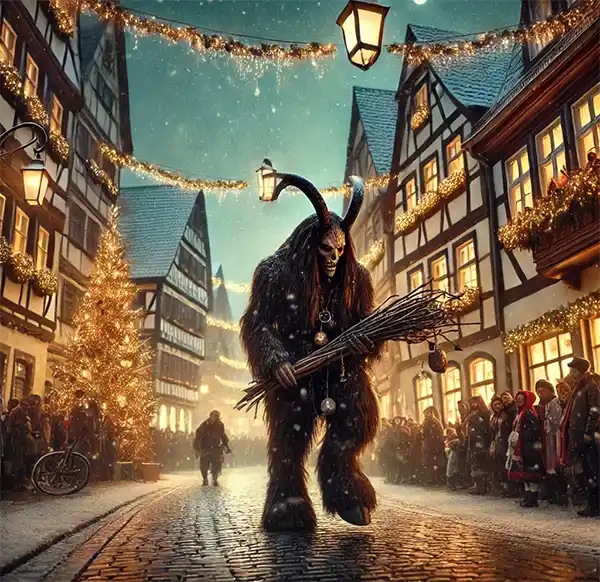 The concept of Krampus is deeply rooted in European folklore, where he is traditionally seen as a counterpart to St. Nicholas, the patron saint of children and the model for Santa Claus. While St. Nicholas rewards the well-behaved with gifts and treats, Krampus serves as a cautionary figure. He is there to remind children that bad behavior has consequences, a stark contrast to St. Nicholas' message of reward and kindness. This dualism reflects a deeper moral narrative, where good is rewarded, and bad is admonished, a theme that resonates in many cultural stories and traditions around the world.
The concept of Krampus is deeply rooted in European folklore, where he is traditionally seen as a counterpart to St. Nicholas, the patron saint of children and the model for Santa Claus. While St. Nicholas rewards the well-behaved with gifts and treats, Krampus serves as a cautionary figure. He is there to remind children that bad behavior has consequences, a stark contrast to St. Nicholas' message of reward and kindness. This dualism reflects a deeper moral narrative, where good is rewarded, and bad is admonished, a theme that resonates in many cultural stories and traditions around the world.
In some traditions, Krampus accompanies St. Nicholas during his visits on the eve of St. Nicholas Day, playing a role similar to that of a disciplinarian. While St. Nicholas dispenses gifts, Krampus is there with his bundle of birch branches, ready to swat not-so-nice children. Some stories even have him carrying a sack or basket on his back, in which he places particularly naughty children to carry away. This imagery presents a vivid contrast to the jolly, red-suited Santa Claus, adding a touch of dark humor and edginess to the holiday season.
In modern celebrations, Krampusnacht serves as a reminder of the holiday's more complex and multifaceted nature. It acknowledges that while the season is predominantly about joy and giving, it also embraces the playful acknowledgment of naughtiness and mischief. This duality adds depth to the holiday experience, allowing for a broader range of expressions and celebrations.
So, as you enjoy the festive lights and the warmth of holiday traditions, spare a thought for Krampus, the brooding presence that adds a dash of spice to the sweet holiday season. His role in the holiday narrative serves as a fascinating counterbalance to the ubiquitous cheer and goodwill, offering a different perspective on the season's festivities.
What to Expect
When Krampusnacht descends, it brings with it an atmosphere that's a far cry from your typical holiday festivity. Krampus, the star of this peculiar show, is a half-goat, half-demon creature who emerges on this night, not to spread cheer but to administer a dose of fear to those who have been more naughty than nice. Imagine a Christmas pageant, but instead of elves and reindeer, you've got a motley crew of Krampi (because, let’s face it, 'Krampus' doesn't pluralize easily!). It's like a holiday office party where everyone has ditched the festive sweaters for something out of a Brothers Grimm tale.
During Krampusnacht, expect the unexpected. Streets, usually filled with the sound of merry carols, are instead echoing with the rattling chains and ominous bellows of Krampus. Participants dress up in elaborate costumes with fur, masks, and horns, transforming into living embodiments of this mythical figure. These costumes are often handcrafted, intricate, and designed to be authentic and intimidating. The effort put into these disguises is a testament to this tradition's importance and excitement.
The figure of Krampus himself is a sight to behold – often portrayed with a ghastly, leering face, complete with fangs and a lolling tongue. He carries chains or ropes, symbolizing his role in capturing the naughty and a bundle of birch branches for swatting at misbehaving children. In some portrayals, he even carries a sack or a basket on his back, ready to whisk away the particularly troublesome kids to unknown fates.
But fear not, for all the ominous trappings, Krampusnacht is more about fun and tradition than genuine terror. The chases and mock punishments are all in good spirit, with participants reveling in the opportunity to spook and surprise each other playfully. It's an evening where adults and children alike can indulge in a bit of mischief and play-acting, stepping into a more wild and whimsical side of the holiday season.
The celebrations are often accompanied by other traditional activities, such as the Krampuslauf or Krampus Run, where people dressed as Krampus parade through the streets, much to the amusement (and sometimes mild alarm) of onlookers. This parade is a spectacle of creativity and folklore, a vibrant and noisy procession that lights up the cold winter night.
What to expect from Krampusnacht? A dash of folklore, a pinch of pageantry, and tongue-in-cheek terror. It's a night when the holiday season embraces its darker, more mischievous side, offering a unique and unforgettable experience that contrasts sharply with the usual holiday cheer.
Celebrated on December 5th, primarily across Germany and other European countries, Krampusnacht is the night before the Feast of St. Nicholas. It's a time when adults and children alike dress up as Krampus, recreating a slightly less jolly, more horned version of caroling. Instead of singing, they chase naughty children through the streets. It's all good fun, unless you forgot to do your homework.
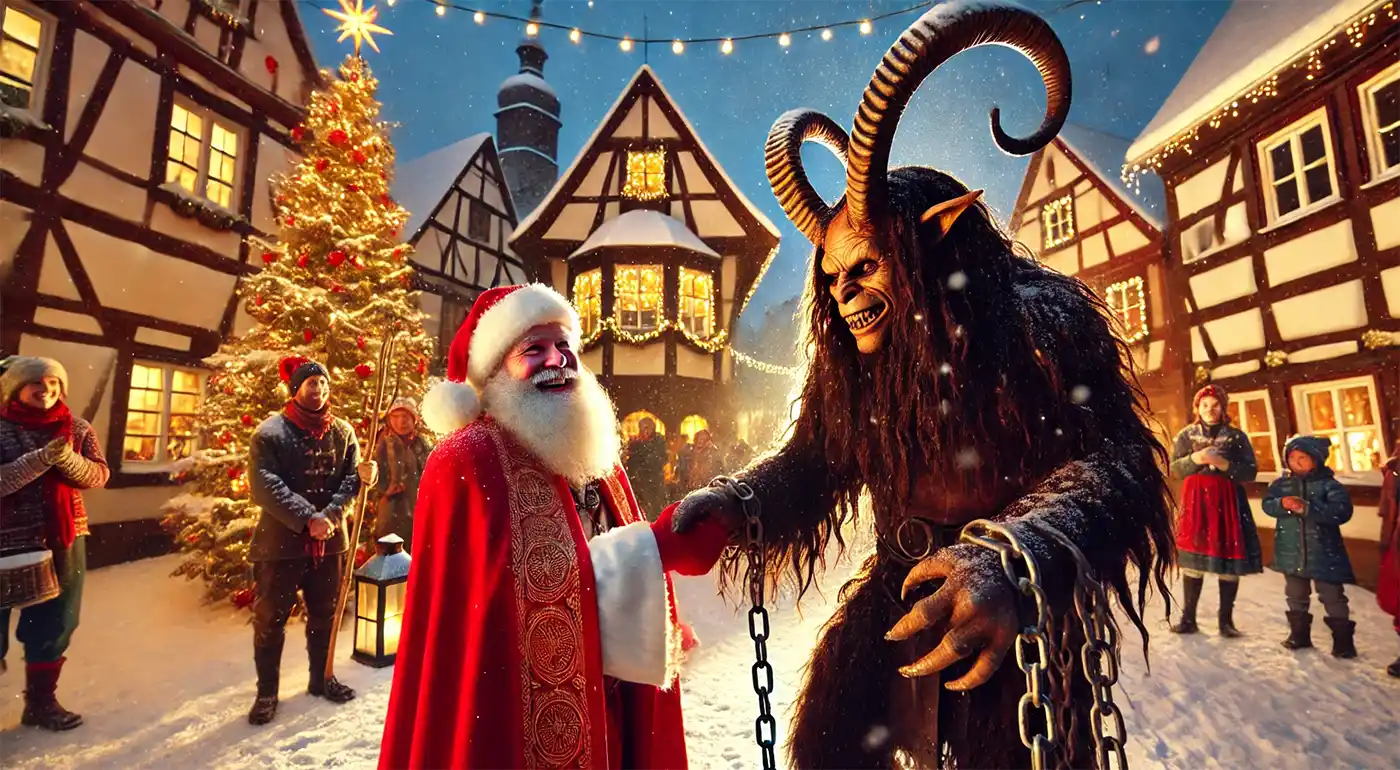
Krampus Run
The Krampus Run, or Krampuslauf, is one of the most iconic and exhilarating aspects of Krampusnacht, transforming streets into a fantastical, if slightly eerie, spectacle. As the name suggests, this event involves participants donning elaborate Krampus costumes and parading through the streets, but it's so much more than just a procession. It's a vibrant, dynamic celebration that melds tradition, performance art, and a touch of good-natured mischief.
Participants in the Krampus Run take their roles seriously, often spending months preparing their costumes. These aren't just any Halloween get-ups; they are works of art, intricately crafted to embody the terrifying visage of Krampus. The costumes typically feature shaggy pelts, fearsome horned masks, and clanking chains, creating an imposing and otherworldly presence. The masks, often hand-carved from wood and artistically painted, display an array of expressions, from snarling menace to mischievous grin, capturing the multifaceted nature of Krampus.
As the procession moves through the streets, the air fills with jingle bells – though not the cheerful kind you'd find on Santa's sleigh. These bells ring with a sinister undertone, a harbinger of Krampus' approach. The participants, fully in character, engage with onlookers, sometimes chasing after the more daring spectators or playfully swatting at them with birch branches. It's a performance that blurs the line between spectator and participant, drawing everyone into the heart of the tradition.
The Krampus Run isn't just a simple parade; it's a theatrical display, a living storybook page that brings myth into reality. As the Krampi moves through the streets, they recreate scenes straight out of Alpine folklore, complete with dramatic interactions and choreographed antics. It's a captivating mix of horror and humor, where scares are met with laughter and shrieks merge with cheers.
In some regions, the Krampus Run is more than just a single evening event; it's part of a series of celebrations throughout the Advent season. Each run has its unique flavor, with different towns adding local traditions and twists to the festivities. From fiery torches to dramatic drumbeats, each Krampus Run is a distinct experience, reflecting the rich cultural tapestry from which the tradition springs.
The Krampus Run is like a marathon of folklore and fantasy. Instead of striving for a medal, participants and spectators alike revel in the thrill of the chase and the joy of the scare. It's a celebration that invites everyone to step into a world where myth and reality dance together under the cold winter sky, reminding us of the ancient roots and the enduring allure of the Krampus legend.
So, as you sip your hot cocoa and wrap presents, spare a thought for the Krampusnacht enthusiasts. They remind us that every good story, especially a holiday story, needs a bit of shadow to make the light shine brighter. Remember, if you hear a clatter on your rooftop this December, it might not be reindeer hooves. Happy Krampusnacht!
Please Share our Content

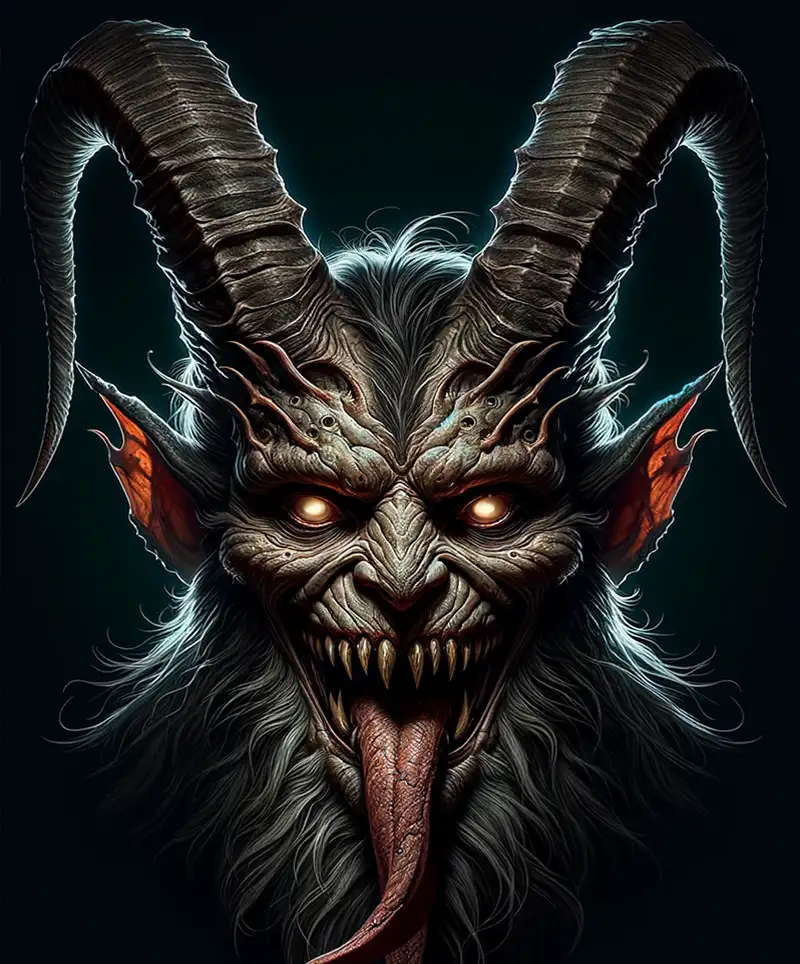
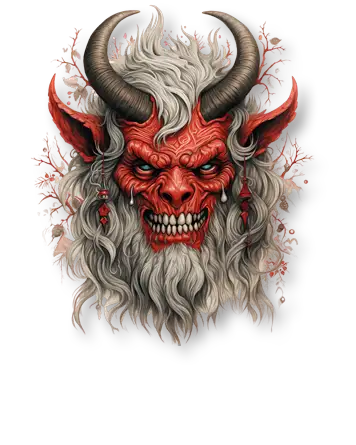



 ht emerges as a daring, almost rebellious celebration, where gleeful fright and playful scares replace the usual holiday norms. This evening is an ode to the thrill-seekers and the folklore enthusiasts, a tribute to an age-old tradition that refuses to be tamed by modern holiday commercialism. It's a time when the crackling fireplaces and cozy sweaters meet the eerie echoes of a different kind of story - one that harks back to a time when myths walked the earth and legends were as real as the winter's chill.
ht emerges as a daring, almost rebellious celebration, where gleeful fright and playful scares replace the usual holiday norms. This evening is an ode to the thrill-seekers and the folklore enthusiasts, a tribute to an age-old tradition that refuses to be tamed by modern holiday commercialism. It's a time when the crackling fireplaces and cozy sweaters meet the eerie echoes of a different kind of story - one that harks back to a time when myths walked the earth and legends were as real as the winter's chill. The concept of Krampus is deeply rooted in European folklore, where he is traditionally seen as a counterpart to St. Nicholas, the patron saint of children and the model for Santa Claus. While St. Nicholas rewards the well-behaved with gifts and treats, Krampus serves as a cautionary figure. He is there to remind children that bad behavior has consequences, a stark contrast to St. Nicholas' message of reward and kindness. This dualism reflects a deeper moral narrative, where good is rewarded, and bad is admonished, a theme that resonates in many cultural stories and traditions around the world.
The concept of Krampus is deeply rooted in European folklore, where he is traditionally seen as a counterpart to St. Nicholas, the patron saint of children and the model for Santa Claus. While St. Nicholas rewards the well-behaved with gifts and treats, Krampus serves as a cautionary figure. He is there to remind children that bad behavior has consequences, a stark contrast to St. Nicholas' message of reward and kindness. This dualism reflects a deeper moral narrative, where good is rewarded, and bad is admonished, a theme that resonates in many cultural stories and traditions around the world.









 "Sláinte!" is a traditional Irish expression used as a toast, equivalent to "Cheers!" in English.
"Sláinte!" is a traditional Irish expression used as a toast, equivalent to "Cheers!" in English.